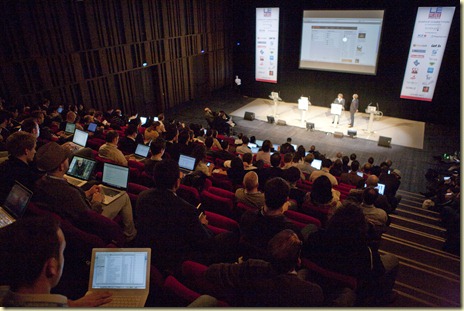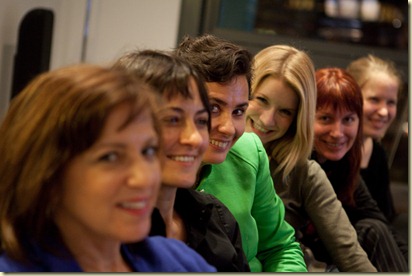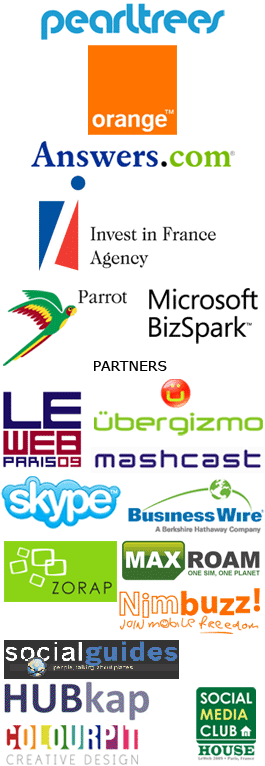Archive for 'Emerging Technologies'
Leweb 2009 – Startups

This is my late and last post covering Leweb 2009. Like every other year (2006, 2007,2008), I will make a roundup of the presenting startups in the conference.
This year, startups didn’t have to pay to present, like in previous years. As a result, the competition seemed opened to more early stage companies and it did show. Only two had already got some VC funding and less than half had significant business angel back-up. There were fewer startups presenting: 16 instead of 30 last year. (more…)
My first batch of Companies at Travelling Geeks
 Here are some of the companies from the first full day of my recent time with the Travelling Geeks project in Paris. I’m not going to write about all the companies that I met during the trip, just the ones that caught my eye and made me want to know a bit more for various reasons, both good and bad. (more…)
Here are some of the companies from the first full day of my recent time with the Travelling Geeks project in Paris. I’m not going to write about all the companies that I met during the trip, just the ones that caught my eye and made me want to know a bit more for various reasons, both good and bad. (more…)
With the Traveling Geeks @ Orange
 This is the last part of my report of the Traveling Geeks tour in Paris before Leweb.
This is the last part of my report of the Traveling Geeks tour in Paris before Leweb.
We met with Orange to have a glimpse of all the solutions they provide to their consumer customers: IPTV, mobile solutions, web solutions, tablets, etc. It took place in the Orange Lab situated at Chatillon, in the southern Paris suburb.
Le Web: Jack Dorsey says he’ll give away Square devices for free
|

Jack Dorsey, the creator of Twitter and co-founder of a new payments startup called Square, said the company will give away its credit card-swiping devices for free at the Le Web conference in Paris today. (See a Q&A with Dorsey here.) It’s a move that should help overcome the biggest hurdle for the startup, and probably help make its money back if it can take a small share of all payments it manages. (more…)
Le Web: Q&A with Google VP Marissa Mayer on the future of search
 Marissa Mayer, Google’s vice president of search and user experience is on-stage at the Le Web conference in Paris. I’m live-blogging as we go:
Marissa Mayer, Google’s vice president of search and user experience is on-stage at the Le Web conference in Paris. I’m live-blogging as we go:
Michael Arrington asks about the search announcements earlier this week (namely Google Goggles, local search and real-time search). (more…)
Dating tech service Wuiper offers a fun way for people to meet
Unless you’re incredibly suave, it can be difficult to impossible to meet someone you want to date. Just walking up to a stranger in a public place and thinking of a way to strike up a conversation and make a connection is not easy. That’s why we have a market for dating technologies, such as online dating sites and devices. All dating technologies have one simple goal: finding a simple, fun, and non-threatening way for people to meet.
Wuiper (pronounced “Whipper”) is a social networking site where people are introduced through physical numbered tags that you can stick on someone’s bag. Geared towards high school students, I can see this being a fun way to leave “secret admirer” messages. Messages can be sent and retrieved via an SMS or via the Wuiper site. All these tags have a code that you use to send a message to initiate a conversation. And then you can continue the conversation through the Wuiper site or take it online or offline.
Related posts:
Parrot’s new Wi-Fi Picture Frame and Wireless Speakers
(This post is part of the Traveling Geeks tech tour of Paris. David Spark (@dspark) is the founder of Spark Media Solutions and a tech journalist that blogs at Spark Minute and can be heard and seen regularly on ABC Radio and on John C. Dvorak’s “Cranky Geeks.”)
At a visit at phone-accessory and gadget maker Parrot in Paris, I interviewed Parrot’s CEO, Henri Seydoux, about a couple of new products: Grande Specchio, a wi-fi picture frame that just came out a few weeks ago, and some giant wireless speakers. (more…)
Traveling Geeks meet 11 Paris startups
On day 2, we arrived at the Paris Developpement Incubateurs an incubator of French tech start-ups. The Travelling Geeks, now with one added Robert Scoble, saw a rapid-fire set of 11 presentations from some very interesting companies and people:
Int13: is a French developer of next-generation games for Smartphones (iPhone, Windows Mobile, Symbian S60, Linux…). They are experimenting with mobile augmented reality games.
CityZeum: provide travel guides for the web and mobile phones, mixing UGC, with expert content and content from journalists.
Scan & Target is a 1-million-euro-funded startup, providing solutions around real-time text mining for web and mobile content (email, SMS, IM, blogs, forums, Twitter).
Rue 89 is a pureplay news website, something between Slate.com and HuffingtonPost. They focus on creating news in a collaborative way via a mixture of journalists, experts and users.
Gostai: Focuses on building a common software platform for Robots, almost like a universal Robot operating system. These guys are way ahead of most mortals.
Zoomorama cares about the “art of information” and is focused on creating a new visual way of surfing the internet and creating presentations. Not too different from innovative Hungarian presentation company, Prezi. Check out more here
Stribe A b2b, Techcrunch50 canditate that’s a plug and play service, allowing a site to instantly create a social network on any website. Sounds quite similar to something else I’m doing actually…
Path Motion. A web 2.0 recruitment play that offers users “friendly questions” to identify their ideal career path, also providing jobs that match them.
MLstate think that web development is “broken” and they want to “rethink web development for the 21th century”. They’re developing One Pot Applications (OPA), a common platform enabling easy development of SaaS web applications.
Teacheo: Is an online tutoring community with virtual classrooms. They make money by linking tutors and students. Simple, but effective. They use 3D modelling to demo items between students and tutors and have good video chat.
Stupeflix: A web service that turns your pictures, videos, and text into professional videos on the fly, just like that!
tags: Paris startups, Traveling Geeks
Potentially related posts
What can you do with a scannable and identifiable model of Paris?
At Silicon Sentier, a startup collective in Paris, I interviewed Maurice Benayoun, Artistic Director of CiTu a research lab for artistic projects. One such project, Terra Numerica, is an easily digestible and programmable scan and index of the city of Paris for which others can use the data to develop applications. City planning and management examples include:
- Walk through Paris virtually like you would in the real world.
- Paris had a flood in 1910 and it’s feared that it’s going to happen again within the next ten years. Simulate the flood and see what the effects of such a disaster would have on the city.
- Virtually raise and lower buildings. See what views would be like.
- Since the database knows where all the cameras are all over the city, you can play a game where you run through the city avoiding security cameras. I asked Benayoun, “Couldn’t this tool be used by criminals?” Watch the video for his response.
Chris Anderson on the democratization of manufacturing and distribution

 Every five or ten years, myself and my colleagues reflect on how much we used to pay for technology and how we’re able to do things we couldn’t do before because it was cost prohibitive.
Every five or ten years, myself and my colleagues reflect on how much we used to pay for technology and how we’re able to do things we couldn’t do before because it was cost prohibitive.
• It used to be too costly to produce a video, then we got non-linear editing on the desktop.
• It used to be too costly to produce a live television program and distribute it, then we got tools like the TriCaster.
• It was unheard of for an individual to produce and broadcast a 24 hour video channel, but then we got a web tool like LiveStream.
These are just a few examples. There are tons more. Technology and the social web have lowered the barrier for so many things that simply weren’t possible without a huge cash investment. The net result is more people with more talent are able to create more products (e.g. music, games, movies, applications, Internet companies, etc.) just as long as they’re digital. The analog world hasn’t had a chance to see this kind of innovative renaissance, until now, said Chris Anderson, Editor of Wired, during a presentation at the Supernova conference in San Francisco.
We’ve created the model for distribution, now let’s use it
If the past decade was about finding new post-institutional social models on the web, then the next decade will be about applying those models to the real world, explained Anderson. In the video production examples above, cheap non-linear editing, video cameras, and online connectivity democratized video production and distribution, making it affordable to all. And as Anderson argues, when you democratize creation and distribution, you vastly change the world. And while we’ve seen this happen again and again in the digital world, we’re now seeing the trend bleed into the physical world, as Anderson demonstrates with a few examples:
-

3D Printer
3D printers that can duplicate nearly any object, which used to cost thousands of dollars, are now available for $750. Anderson has one in his basement.
- Access to manufacturers in China that companies like Sony use is now available to everyone using the manufacturer directory Alibaba along with its international real-time communications tool, TradeManager.
- While it’s still expensive to open up a brick and mortar store, distribution is possible through ecommerce.
What all this means is individuals now have access to manufacturing and distribution and they can compete with Walmart. Anyone, not just major manufacturers, now have affordable access to platforms for micromanufacturing the long tail of physical goods. This is how the web revolution hits the real world, said Anderson.
Small companies filling market gaps
Micro manufacturers are also filling niche markets that major manufacturers don’t want to fill for a number of reasons, such as brand affiliation. In another example, Anderson talked about the squeaky clean image Lego maintains. They’ve got a very wholesome product with a wholesome brand and they want it to stay that way.
 While wholesome-only products is what Lego wants to put out, there’s an audience that wants more. Enter Brickarms Covert Weapons Pack, mini toy weaponry for your Lego characters. Anderson spoke with Lego and asked them what they thought of Brickarms. Turns out they’re totally fine with Brickarms making these Lego weapons. Lego just doesn’t want to be in that market. They’ve got a brand to maintain.
While wholesome-only products is what Lego wants to put out, there’s an audience that wants more. Enter Brickarms Covert Weapons Pack, mini toy weaponry for your Lego characters. Anderson spoke with Lego and asked them what they thought of Brickarms. Turns out they’re totally fine with Brickarms making these Lego weapons. Lego just doesn’t want to be in that market. They’ve got a brand to maintain.
With micromanufacturing, small companies can fill unmet market gaps.
Vertical integration is no longer necessary to reduce overhead
Anderson closed his presentation talking about two very different philosophies of production. Before the democratization of the Internet, the manufacturing model required businesses to internalize all transactions so as to minimize costs. But today, manufacturers can minimize transaction costs through a web of connectivity.
Creative Commons images by Roo Reynolds and G-Sta on FlickrDavid Spark helps businesses grow by developing thought leadership through storytelling and covering live events at Spark Media Solutions. He blogs at The Spark Minute and can be heard and seen regularly on ABC Radio, Cranky Geeks with John C. Dvorak, and KQED in San Francisco. See his business profile, contact David, or leave a comment below.
![]() Tweet It!
Tweet It! ![]() Buzz This Post
Buzz This Post ![]() Delicious
Delicious ![]() Digg This Post
Digg This Post ![]() Facebook
Facebook ![]() Reddit
Reddit ![]() Stumble This Post
Stumble This Post

This work is licensed under a Creative Commons Attribution 3.0 Unported.






